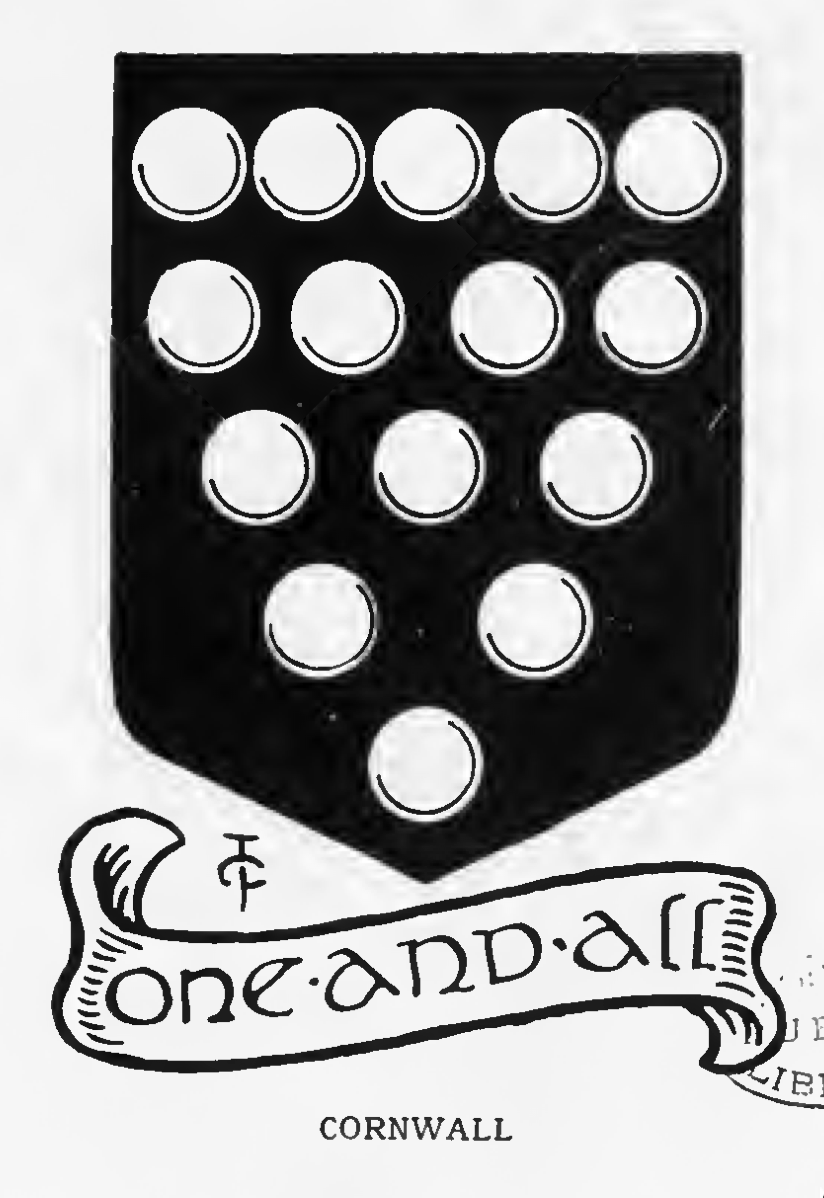CORNWALL.
CORNWALL. Sable, fifteen bezants, five, four, three, two, and one. Motto — " One and all."
These arms are recorded in the Heralds' College as the arms of the Duchy of Cornwall. The seal of the County Council also displays them. Many derivations and meanings have been hung on the foregoing, and Planchd (in his " Pursuivant of Arms "), who was seldom at fault, gives the following explanation.
" But to begin with the Golden Roundel, which is called a Bezant, from a coin of Byzantium or Constantinople, whence the popular conclusion that this charge was introduced into Armory during the Crusades, although its being called after something it resembled, does not quite prove the source of its adoption, as it was sometimes called a Talent, from the coin of that name. Upton blazons the arms of the Duke of Cornwall with a ' bordure de sable Talentee.' The border Bezantee or Talentee of Richard King of the Romans also is no representation of coins, but of Peas (Poix), being the arms of Poitiers or Poictou (Menestrier, Orig. p. 147), of which he was Earl, and not of his other Earldom of Cornwall, as imagined by Sandford and others. The adoption of the Bezants as the arms of Cornwall, and by so many Cornish families on that account, are all subsequent assumptions, derived from the arms of Earl Richard aforesaid, the Peas having been promoted into Bezants by being gilt, and become identified with the Cornish Escutcheon, as the Garbs of Blundeville are with that of Chester, or the coat of Cantelupe with that of the See of Hereford. It has been pointed out to me that the arms of Poitiers given by Menestrier refer to the family of that name, and not to the city or the province of Poictou. This was not apparent in the edition I possess. But, conceding this point, I still adhere to my poix, as, with the exception of Edmond, son of Richard, Earl of Cornwall, who bore the whole arms of his father, I do not find the Earls of Cornwall, who were not Earls of Poictou, bearing bezants in any way. John of Eltham, Earl of Cornwall, as the son of Edward H., might prefer to bear England with a border of France ; but the arrogant favourite Piers Gaveston, Earl of Cornwall, who we might naturally suppose would have gloried in the display of the ancient coat of his earldom, presents us only with three or six eagles. The fact of roundlets being borne by the family of Poitiers is still valuable as collateral evidence, if, on the other side, we are to attach any importance to the bearing of bezants by Cornish families, the family of Cornwall continue to bear the arms of the Earl of Poictou, from whom they are illegimately descended ; and therefore that coat cannot be brought in support of one opinion more than the other. Otho, Earl of Poictou, it is said, has only a lion on his shield ; but, then, Otho was the son of Henry the Lion, of Brunswick, and that was his paternal coat. We have no proof that he bore it as the arms of his earldom."
Another explanation, which figured in a letter to the Western Morning News, is as follows : —
" In the days of the earlier Plantagenets the pawnbrokers of Cornwall were the most enterprising and prosperous merchants in all England. When King
John desired to hypothecate his crown jewels to raise money for a war in France, 5 of the principal ' uncles ' of Cornwall — Ben Levi, of Truro ; Ben Ezra, of Penzance; Moses, of Mevagissey (the other two names are illegible, see Manuscript CXLIX., British Museum) — formed an association, the Ancient and Hon. Association of Pawnbrokers, to take over his debts. The ' trade-mark ' of the company was fifteen balls (the three balls of the five merchants united into one bunch), with the motto ' One and All ' to indicate that no business could be arranged without a quorum of all five members.
"When Edward I. ascended the throne this association was the most powerful in Cornwall. That Prince, following out his usual policy of exalting the merchant class, chose the trade-mark of the Ancient and Honourable Association of Pawnbrokers to be the coat-of-arms of the county of Cornwall.
" Further information on the subject will be found in ' An Ancyent and Ynterestyng Account of Ye Cornish Arms,' of which there is a copy in the British Museum."
Original Source bookofpublicarms00foxd_djvu.txt near line 7692.

Please Help!
DrawShield is a Free service supported by its users.

If you can, please help cover the cost of the server, or just buy the team a coffee to say thanks!
 Buy me a coffee
Buy me a coffee


